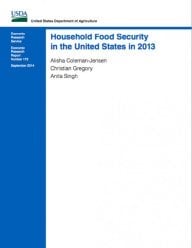 Today the United States Department of Agriculture released its annual report on household food security in the US. With an estimated 14.3 percent of American households experiencing food insecurity during 2013, the state of hunger is the US remains virtually unchanged. While government nutrition programs and emergency food distribution remain essential to keeping families, veterans, seniors, working adults and children nourished and healthy, it is time to embrace a long-term vision for community food security.
Today the United States Department of Agriculture released its annual report on household food security in the US. With an estimated 14.3 percent of American households experiencing food insecurity during 2013, the state of hunger is the US remains virtually unchanged. While government nutrition programs and emergency food distribution remain essential to keeping families, veterans, seniors, working adults and children nourished and healthy, it is time to embrace a long-term vision for community food security.
This vision includes:
- a living wage;
- increased access to nutritious food in underserved communities;
- a clear plan to increase access to jobs and affordable housing;
- investments in local food and farm economics;
- support for community-based programs that promote self-reliance;
- policies and practices that mitigate climate change and its potential devastating impact on crops and livestock worldwide;
- a strengthened and improved government safety net in the form of federal food programs like SNAP, National School Lunch and School Breakfast and WIC and other basic benefits;
- a shift in our food system, to one that nourishes whole communities and values people over profits.
Community food security means that all people have access to a safe, culturally acceptable, nutritionally adequate diet through a sustainable food system that maximizes community self-reliance and social justice. It is unique in its focus on the entire food system from the farms where food is grown to the tables where it is eaten.
“Hunger persists in our world because people cannot afford to buy food or because they are denied access to the land, water and other resources they need to produce their own food,” says Alison Cohen, senior director of programs at WhyHunger. “Hunger is not just a food issue, it’s a complex economic, social and environmental issue. We will not see significant improvements in the hunger statistics in this country until we dismantle the broader policies that perpetuate hunger and start investing in the many communities that are working at the intersection of those sectors to nourish people and change their local food systems.”
As we respond to this newest set of data and continue the discussions of domestic hunger and federal food programs, we must connect the dots to the inherently relevant issues – both assets and challenges – that define our food system, from nutrition education, family farms, rural poverty, and local and regional food systems.
Investing in community-based solutions and partnering with grassroots organizations, youth leaders, policy-makers, chefs, farmers, filmmakers and activists has allowed the community food security movement to build alliances which can confront not just food insecurity, but also the problems facing the entire food system.
Take action by continuing to push Congress to strengthen the federal nutrition programs and institute a living wage or get involved in climate change and the community food security movement.


